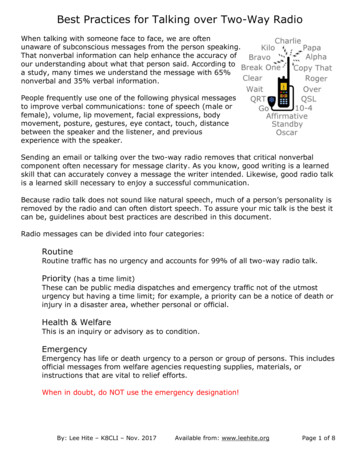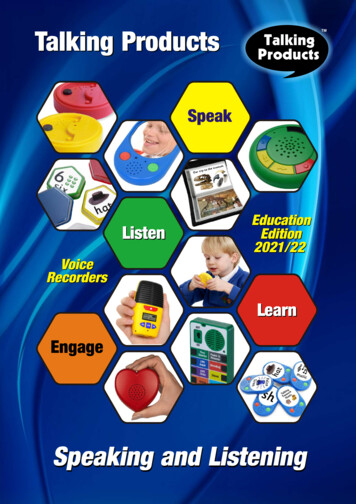
Transcription
Best Practices for Talking over Two-Way RadioWhen talking with someone face to face, we are oftenunaware of subconscious messages from the person speaking.That nonverbal information can help enhance the accuracy ofour understanding about what that person said. According toa study, many times we understand the message with 65%nonverbal and 35% verbal information.People frequently use one of the following physical messagesto improve verbal communications: tone of speech (male orfemale), volume, lip movement, facial expressions, bodymovement, posture, gestures, eye contact, touch, distancebetween the speaker and the listener, and previousexperience with the speaker.Sending an email or talking over the two-way radio removes that critical nonverbalcomponent often necessary for message clarity. As you know, good writing is a learnedskill that can accurately convey a message the writer intended. Likewise, good radio talkis a learned skill necessary to enjoy a successful communication.Because radio talk does not sound like natural speech, much of a person’s personality isremoved by the radio and can often distort speech. To assure your mic talk is the best itcan be, guidelines about best practices are described in this document.Radio messages can be divided into four categories:RoutineRoutine traffic has no urgency and accounts for 99% of all two-way radio talk.Priority (has a time limit)These can be public media dispatches and emergency traffic not of the utmosturgency but having a time limit; for example, a priority can be a notice of death orinjury in a disaster area, whether personal or official.Health & WelfareThis is an inquiry or advisory as to condition.EmergencyEmergency has life or death urgency to a person or group of persons. This includesofficial messages from welfare agencies requesting supplies, materials, orinstructions that are vital to relief efforts.When in doubt, do NOT use the emergency designation!By: Lee Hite – K8CLI – Nov. 2017Available from: www.leehite.orgPage 1 of 8
Best practices for radio talk use the Five C’s of radio communication, aka “traffichandling”: Clear, Concise, Correct, Confident, and Complete.ClearRecognizing that what can go wrong will go wrong, make sure what you are sayingcannot be misinterpreted. Use short simple sentences. Your voice should be clear.Speak a little slower than normal. Speak in a normal tone; do not shout. Do notmumble, use big words, or ramble with mumbo jumbo when a handful of commonwords will do. Do not speak too fast. Did you say what you meant? Instead ofsaying “We’re getting hungry over here,” say “Bring us some food!”Instead of “We need more people here,” consider saying “We need six morepeople capable of clearing heavy debris working in a wet and cold environment.”Confusing: a D sounding like a V, a P sounding like a B, a G like a C, an E like a T,an F like an X, a K like a J or even like an A, an M like an NConfusing: “That is mine” sounding like “That is mined” or like “That is nine”Phonetically, the word “NINE er” is used to minimize confusion.Confusing: “Send Paul” sounding like “Send all”ConciseStick to your point and do not confuse the message with irrelevant information.Do not beat around the bush and do not wander off message.CorrectIs the information factually accurate? If estimates are the best you have, say that.Poor grammar or sentence structure can undermine confidence.Avoid judgmental information.Do not transmit confidential information on a radio unless you know the propersecurity technology is in place. Remember, frequencies are shared; you do nothave exclusive use of the frequency, assume people not associated with yourgroup will be listening. Do not broadcast the names of under age children.ConfidentKeep your voice calm and steady even if you are feeling stressed. Do not let yourvoice convey unnecessary emotions. Be confident in your communication. Knowthe facts.CompleteDoes the message meet needs? Is there enough information so the recipient canaccurately act upon the information?By: Lee Hite – K8CLI – Nov. 2017Available from: www.leehite.orgPage 2 of 8
Message or Traffic Handling ProtocolsSuccessful radio communication can depend on the amount of noise from thesurrounding environment or by electrical interference on the channel, differences inoperating style, dialect, and poor enunciation. Practicing good radio protocol can help toeliminate failed communications. Listed alphabetically below are typical codes or phrasesused to enhance clarity.Break Or Break OneHold Or Hold OneBreak for AdditionalThe “one” refers to amoment in time that has notime limit.ClearOutQRT (ham radio)EndStop10–3 (CB radio, notrecommended)Come InContinuingCopyCopy ThatGo AheadGoOverFrequently, there are reasons to pause in the middle of atransmission. On a long message, pause to allow therecipient to scribe the message and to allow emergencytraffic to break in and receive attention.The end of your message session should be followed byan “end of session code” that signals this is the lasttransmission, so do not expect further information. Theend code opens the channel to the next user.You are asking the other party to acknowledge they hearyou.After a pause, the sending station may say “Continuingwith the previous message.”Did you understand what was said?Question MarkRepeatSay AgainThe end of a transmission should be followed by an “endcode” to alert the listener that you have finishedspeaking, as opposed to the radio going quiet or dead.If the receiving station is missing information or does notunderstand, the phrase “Question Mark” or “Repeat”or “Say Again” can be used to ask for an informationrepeat.Radio CheckWhat is my signal strength? Can you hear me?Read Loud and ClearResponse to "Radio Check.” Means your transmissionsignal is good.Read 5 by 9Means good clarity and excellent signal strengthBy: Lee Hite – K8CLI – Nov. 2017Available from: www.leehite.orgPage 3 of 8
RogerRoger RogerQSL (ham radio)AffirmativeNegative10–4 (CB radio)Standby or Standby One,Wait or Wait One.The “one” in “standby one”refers to a moment in timethat has no time limit.After you finish a transmission, you may be unsure themessage was received. To eliminate doubt, you can askfor an “acknowledgement” such as “did you copy that?”The receiving station may use one of the followingacknowledgments:RogerRoger Roger (used under poor receiving conditions)QSL (ham radio Q-Code abbreviation)Affirmative (means “Yes”)Negative (means “No”) (Avoid "yup" or "nope" as they aredifficult to hear.)10–4 (CB radio, not recommended)A standby, or wait, is a temporary interruption, or pausein the transmission. The session has not ended, but thesending station needs to address other importantbusiness.In addition, the standby (or wait) code can let the stationknow they have been heard but you are unable torespond immediatelyEventually the session will continue. The channel shouldnot be released for use by other communicators.Meaning: "I will comply."WilcoThink Before SpeakingWhen you transmit a message, take a few seconds to think about what you are going tosay before saying it. Gathering adequate information is the responsibility of the operatororiginating the message.Pressing the PTT (Push to Talk) button and saying “umm” and “ahhhh” because you’retrying to think of what to say is annoying and time wasting. When multiple people areusing a channel, this behavior reduces availability for others.Transmitting (Beginning a Communication Session)When you begin a new session and know what you are going to say, press and hold thePTT button for one to two seconds before speaking. This allows radios that have goneinto sleep mode (for battery conservation) to “wake up.” You could cut off the first partof your transmission if you talk too soon.Release the PTT and listen to confirm the channel is clear. Push the PTT and begin themessage by announcing your identification (This is command , This is Team B , Thisis “ham call sign” , or This is logistics , etc.)Announce why you started this session (Calling Team A , Calling the VRC or This isan announcement for all stations .)By: Lee Hite – K8CLI – Nov. 2017Available from: www.leehite.orgPage 4 of 8
Emergency CallsIf you have an emergency message and need to interrupt other conversations,wait and listen until you hear "Over" from the station using the channel. Press PTT andsay "BREAK, BREAK, BREAK, [your identification], I have an emergency message for[receiving station identification], Do you copy?, Over."A typical two–way radio session is described below. Embedded within this session areseveral codes that help clarify the communication process.(Command) Command calling logistics. Over.(Logistics) This is logistics. Go ahead.(Command) How many backpacks are available for immediate use? Go ahead.(Logistics) We have 6 backpacks now and 14 additional by tomorrow morning.How many do you need? Go.(Command) Question Mark. Did you say you have 6 backpacks? Go.(Logistics) Roger, we have 6 backpacks. Go.(Command) We need 7. Can you deliver 6 bags today by 2 PM to the VRC? Go.(Logistics) Affirmative, we can deliver 6 backpacks today by 2 PM to the VRC. Over.(Command) Proceed with that delivery. We’re clear.How to Communicate Under Poor Receiving or Transmitting Conditions.Scene noise or radio noise can contribute to poor communications.If the receiving station has not understood the “number” in the message, often the“Stop Count” technique is used. For example: you want to convey the number 5 (five).Count to 5 and stop: 1, 2, 3, 4, 5. Another method is to use the number in a phrase,such as 1945.Poor communications can be caused by microphone wind noisefrom natural wind or from aspirated consonants. Vowels do notproduce wind, but excessive puffs of air are caused by consonants:B, C, D, F, G, H, J, K, L, M, N, P, Q, R, S, T, V, W, Y, Z.For this reason, never speak directly into the microphone. Instead, hold it to the side ofyour mouth so the burst of air travels perpendicularly to the microphone. A fewexamples are shown below.By: Lee Hite – K8CLI – Nov. 2017Available from: www.leehite.orgPage 5 of 8
Scribing A MessageThe radio message should be written, rather than verbal, when relaying a message fromone point to another. Often your host organization will have prepared a form to handoffmessages. If not—and you can use plain paper—make sure to scribe the minimumamount of information necessary for an accurate memorandum. Here is one example inaddition to the samples that appear at the bottom of this page:ToFromDate Message ReceivedTime Message ReceivedBody of MessageDelivered To (if different from person or agency identified in “To” above)Time Message DeliveredStation IDAvailable time to scribe a message can be limited, but avoid using shortcuts andabbreviations not likely understood by the recipient. Bear in mind that figures take lesstime to write than words take: 7, instead of seven.By: Lee Hite – K8CLI – Nov. 2017Available from: www.leehite.orgPage 6 of 8
If you need to copy a message when the transmitting station is using the“Phonetic Alphabet,” it is good to know there are two lists, as described here.Often, communicators will just make up words and not use either alphabet.Law EnforcementPhonetics AlphabetA AdamB BoyC CharlieD DavidE EdwardF FrankG GeorgeH HenryI IdaJ JohnK KingL LincolnM MaryN NoraO OceanP PaulQ QueenR RobertS SamT TomU UnionV VictorW WilliamX X-rayY YoungZ ZebraABCDEFGHIJKLMNOPQRSTUVWXYZBy: Lee Hite – K8CLI – Nov. 2017International Phonetics AlphabetNATO, Military, Fire and EMS,Aviation, Amateur RadioAlpha (AL fah)0 ZEE rowBravo (BRAH VOH)1 WUNCharlie (CHAR lee)2 TooDelta (DELL tah)3 TREEEcho (ECK oh)4 FOW erFoxtrot (FOKS trot)5 FIFEGolf (GOLF)6 SIXHotel (hoh TELL)7 SEVENIndia (IN dee ah)8 AITJuliet (JEW lee ETT)9 NINE erKilo (KEY loh)Lima (LEE mah)Mike (MIKE)November (no VEM ber)Oscar (OSS cah)Papa (pah PAH)Quebec (keh BECK)Romeo (ROW me oh)Sierra (see AIR rah)Tango (TANG go)Uniform (YOU nee form)Victor (VIK tah)Whiskey (WISS key)X Ray (ECKS RAY)Yankee (YANG key)Zulu (ZOO loo)Available from: www.leehite.orgPage 7 of 8
Two-Way Radio Communications - Best PracticePushto TalkPTTPushStarting a Communication SessionCallingWho’sAsk for aPTTCallingResponse,Signal youare donetalkingCallingThis isCome In ReleaseTeam A Team B Go AheadCallingGoResponding StationResponseTurn the channelback to Team AThis isTeam AGo AheadGoOverOverPPTPPTPPTThis isTeam BThis isTeam BThe MessageTeam A, canGo Aheadyou send threeGopeople to theOverfire station?MessageYes, Team A,please sendtwo people tothe firestation, doyou copy?Go AheadGoOverCommunicating the MessageThis isThank you,Team B isTeam B Team A, that isClear orall we need.OutBy: Lee Hite – K8CLI – Nov. 2017UnPPTUnPPTUnPPTResponding StationThis is team AGo AheadWe have twoGopeople availableOverbut not three,will that work?Responding StationAffirmative Team Go AheadB, we copy. WeGowill send twoOverpeople to the firestation.Responding StationCopy that,Team A is clearAvailable from: www.leehite.orgPage 8 of 8
removed by the radio and can often distort speech. To assure your mic talk is the best it can be, guidelines about best practices are described in this document. Radio messages can be divided into four categories: Routine Routine traffic has no urgency and accounts for 99% of all two-way radio talk. Priority (has a time limit)











